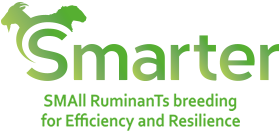
This project has received funding from the European Union’s Horizon 2020 research and innovation programme under grant agreement No 772787.
Public Deliverables
- D1.1: Report of novel phenotypes related to feed efficiency
- D1.2: Report on genetic correlations of feed efficiency and other economically important traits
- D1.3: Peer-rewiewed paper on the genetic basis of feed resource use utilisation
- D1.4: G×E interaction for the resource use efficiency related phenotypes
- D2.1: Report on new immunological and physiological profiles linked to disease phenotypes in locally-adapted breeds
- D2.2: New breeding goals for lifetime resilience for maternal sheep breeding programmes
- D2.3: Paper of quantification of new disease biomarkers linked to production. New disease phenotypes for endemic diseases linked to key production traits
- D2.4: New prototype and report for industry on GPS-generated phenotypes for behavioural adaptations to extensive grazing systems; artificial rearing adaptation phenotypes; lamb vigour scores linked to lamb survival; new foetal and neonatal survival phenotypes
- D2.5: Genome-wide association studies for resilience traits in small ruminant populations in Europe and Uruguay
- D3.1: Submitted scientific publication on the genetic parameters between efficiency, resilience and reproduction related traits in sheep and goats
- D3.2: Report on the characterization of efficiency and resilience in lines of sheep and goat divergently selected
- D3.3: Scientific manuscript and source code of prediction models for trade-offs under nutritional and infectious challenges
- D3.4: Report on identified pleiotropic QTLs and potential undelying genes and pathways associated efficiency, resilience and re-production related traits
- D3.5: Report on trajectory characteristics of resilient animals, and strategies to manipulate these
- D4.2: Report on demography and genetic diversity of underutilised breeds
- D4.4: Papers on genetic characterization demography and adaptation of local small ruminant breeds
- D5.1: Method for identifying environmental challenge events and value for selection for resilience
- D.5.2: A report of an improved method to calculate genomic relationship across individuals of different purebred and crossbred populations
- D5.3: Method for assessing potential bias due to design of cross validation analysis
- D5.4: A report for optimum contribution to manage diversity at critical regions and to assist mating design to maximise heterozygosity and expression of heterosis and evaluation of level inbreeding rate across genomic regions and their impact on performance
- D5.5: A manuscript on the development and testing of genomic evaluation tools to improve resilience and efficiency accounting for the impact of environmental challenge and using novel phenotypes
- D6.1: Document specifying the exchange of pedigree, phenotypes and genotypes
- D6.2: Submitted scientific publication on the variance components for pilot ruminants breeds in a pilot selection of countries
- D6.3: Guidelines for recording efficiency and resilience traits in sheep and goats
- D6.4: Business/operation model for international evaluation of rams and bucks
- D6.5: Report on cost-effectiveness of harmonization in phenotyping and of international evaluation
- D7.1: Farmers and breeders’ practices and preferences for breeding and genetics
- D7.2: Productive, resilient or efficient? The ideal animal for small ruminant breeders: a five-country case study
- D7.3: Paper on economic, labour and environmental tradeoffs for breeding for R&E traits
- D7.4: Report on Summary of WP7 and recommendations for breeding. Simulations of Lacaune sheep and Alpine and Saanen goat breeding programs
- D8.1: Website on-line & Communication package
- D8.3: First batch of practice abstracts for end-users
- D8.4: Schedule and program of the summer school, eLearning and training sessions and multi-ac-tor round tables
- D8.5: Second batch of practice abstracts for end-users
- D8.6: Report of the final scientific conference
- D8.7: Compilation of training sessions reports
- D8.8: Report on dissemination, communication and exploitation activities

